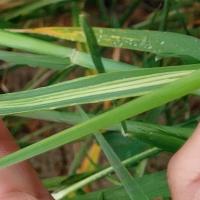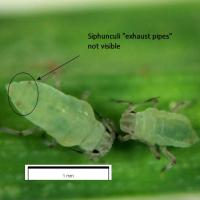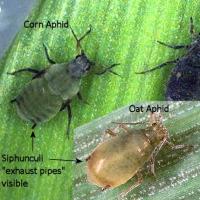Russian wheat aphid (Diuraphis noxia) has been found in Western Australia for the first time in 2020. It was detected in Australia for the first time during 2016 in South Australia, Victoria and New South Wales. Western Australian grain growers are urged to monitor cereal crops for signs of this pest and apply controls if the aphid exceeds thresholds. The threshold depends on the growth stage of the cereal crop.
Diagnosing Russian wheat aphid
What to look for
- Russian wheat aphid is a small lime-green aphid with an elongated body. Adults are 1.4-2.3mm in length, the antennae are short, as are the cone shaped siphunculi (sometimes called cornicles). Supracaudal process is present, giving the appearance of a double tail. In South Australia during 2016, it was observed that Russian wheat aphid was often found as a low percentage of mixed colonies with other cereal aphid species (that is, 5% Russian wheat aphid, 95% corn aphid).
Insect Adult
- Russian wheat aphid is a small lime-green aphid with an elongated body. Adults are 1.4-2.3mm in length, the antennae are short, as are the cone shaped siphunculi (sometimes called cornicles). Supracaudal process is present, giving the appearance of a double tail. In South Australia during 2016, it was observed that Russian wheat aphid was often found as a low percentage of mixed colonies with other cereal aphid species (that is, 5% Russian wheat aphid, 95% corn aphid).
- Aphid damage is often found at the base and sheath of newly emerged leaves. Cereal crops infested with Russian wheat aphid can become purplish and develop longitudinal yellowish and whitish streaks. Infested plants may be stunted and damaged areas may appear in hotspots or along field edges. Tillers of heavily infested plants can run parallel to the ground and leaves can roll longitudinally. Curling of the flag leaf can cause emerging heads and awns to become trapped. From a distance, damage may appear as a general loss of colouration across the affected crop area.
Insect Adult
What else could it be
| Condition | Similarities | Differences |
|---|---|---|
| Diagnosing cereal aphids | Aphid present on cereal crops | Russian wheat aphid are small in size, green in colour, elongate in shape with very short antennae and an apparent lack of cornicles (exhaust pipes) |
| Diagnosing wheat streak mosaic virus | Longitudinal striping of leaves sometimes present | Absence of aphids near the base of newly emerged leaves |
| Diagnosing group B herbicide damage in cereals | Changes in leaf colouration including yellow or white stripes and sometimes purpling | Absence of aphids near the base of newly emerged leaves |
|
Damage from thrips or mites
|
Where does it occur?
- Russian wheat aphid can occur on a range of cereal crops and grass weeds including wheat, barley. Wheat and barley are the most sensitive crops to damage from Russian wheat aphid. Oats are not considered to be susceptible.
Where did it come from?
- Russian wheat aphid was detected in Australia for the first time during 2016. Conditions favourable to larger infestations include an early break to the growing season, the presence of hosts which include volunteer cereals and grasses such as barley grass during the period leading up to seeding.
Management strategies
- Apply registered insecticides if RWA are above thresholds.
How can it be monitored?
- Research investment by the Grains Research and Development Corporation (GRDC) has found the best metric for predicting yield loss from RWA is to determine the percentage of tillers with RWA. On average, for each percent of tillers with RWA there is 0.28 % yield loss. The most at risk time for the crop is from stem elongation to when the flag leaves emerge. Monitor for RWA by walking through the crop in a 'W' pattern, noting the numbers of aphids per tiller at every few paces. Do this in more than one location in the paddock.
See also
Further information
Page last updated: Tuesday, 17 August 2021 - 1:51pm




